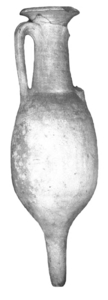Roman Amphorae: a digital resource
University of Southampton, 2005. (updated 2014) https://doi.org/10.5284/1028192. How to cite using this DOI
Data copyright © University of Southampton unless otherwise stated
This work is licensed under the ADS Terms of Use and Access.
Primary contact
Dr
David
Williams
Dept of Archaeology
University of Southampton
Avenue Campus
Highfield
Southampton
SO17 1BJ
England
Tel: 080 593032
Resource identifiers
- ADS Collection: 463
- DOI:https://doi.org/10.5284/1028192
- How to cite using this DOI
Dressel 8

Formerly identified as Beltrán 1/Camulodunum 186A. Courtesy of Museo Arqueològic d' Empúries
David Peacock
Distinctive FeaturesThis form has a bell shaped mouth with a thickened short rim which has a concave outer face, a heavy cylindrical neck with long flattened handles sharply bent over below the rim and a 'radish-shaped' body which has a long hollow spike (Peacock & Williams, 1986: Class 17).Pompeii 7 is closely allied to this form but has a slightly more upright rim and thicker ridged handles. See characteristics | ||
Date RangeBetween c. 15 BC (Lyon) and the Flavian period (García Vargas, 1998)Search: [1st century BC] [1st century AD] [2nd century AD] | ||
OriginThe Baetican coast, particularly in the workshops in the modern provinces of Cádiz, Málaga and Huelva. One of the main centres seems to be at Villanueva (Puerto Real, Cádiz). The latest production of Dressel 8 has been documented at the kilns of Puente Melchor (Puerto Real, Cádiz) and El Torno (Jerez de la Frontera, Cádiz).Workshops in the modern province of Cádiz: Buenavista, Cerro de las Cabezas, La China, Molino Platero (El Puerto de Santa María); La China, Molino Platero, El Almendral, La Cabaña I, Cantera de Lavalle II, Las Canteras, Casa de la Tinaja, Cerería, Fábrica Lavalle, El Gallinero, Olivar de los Valencianos, Puente Melchor, Villanueva (Puerto Real); Cerro de los Mártires (San Fernando). Workshops in the modern province of Málaga: Haza Honda (Málaga). Search: [North West Europe] [Spain] [Western Mediterranean] | ||
DistributionWestern Roman provinces, north Africa; eastern Mediterranean. Findspots include: Rome, Ostia, Pompeii, Herculaneum, Luni, Concordia Sagittaria, Altino, Padua, Verona, Vindonissa, Augst, Mainz, Magdalensberg, Emona, Poetovio, Colchester, Lyon, Sala, Caesarea Maritima.Search: [Eastern Mediterranean] [France] [Germany] [Great Britain] [Italy] [North Africa] [North West Europe] [Switzerland] [The Levant] | ||
ContentsTituli picti suggests fish-sauce (Beltrán Lloris, 1970):g(ari) f(los) (CIL. XV, 4689, 4691, 4693, 4694, 4701, 4703, 4704, 4706, 4707, 4711, 4718). g(ari) s(combri) f(los) (CIL. XV, 4692). g(ari) f(los) scomb(ri) on Dressel 8 found at Saint-Roman-en-Gal. g(ari) scomb(ri) flos, on Dressel 8 found at Mainz. Two doubtful tituli cite liquamen (CIL. XV, 4718) and laccatum (CIL. XV, 4734). Search: [Fish Sauce] | ||
CommentsPrincipal contributor: Lazaro Lagóstena | ||
ClassificationAugst 25Beltrán 1 Camulodunum 186A Dressel 8 Baetican Peacock & Williams 17 Pompeii 7 Schoene-Mau 7 Vindonissa 586 | ||
CEIPAC linkThe following link will take you to the Centro para el Estudio de la Interdependencia Provincial en la Antiguedad Clásica CEIPAC database. In the CEIPAC system this amphora has the ID KE51+BYZ. Note: access to CEIPAC requires registration, which is possible via http://ceipac.ub.edu/corpus_reg.php?IDM=e | ||
Terres dâAmphoresTerres dâAmphoresThe above link will take you to the new digital database of amphora types and fabrics from Gaulish production centres, 1st - 3rd century A.D. (Maison Archéologie & Ethnologie, René-Ginouvès). | ||



 3D models
3D models


